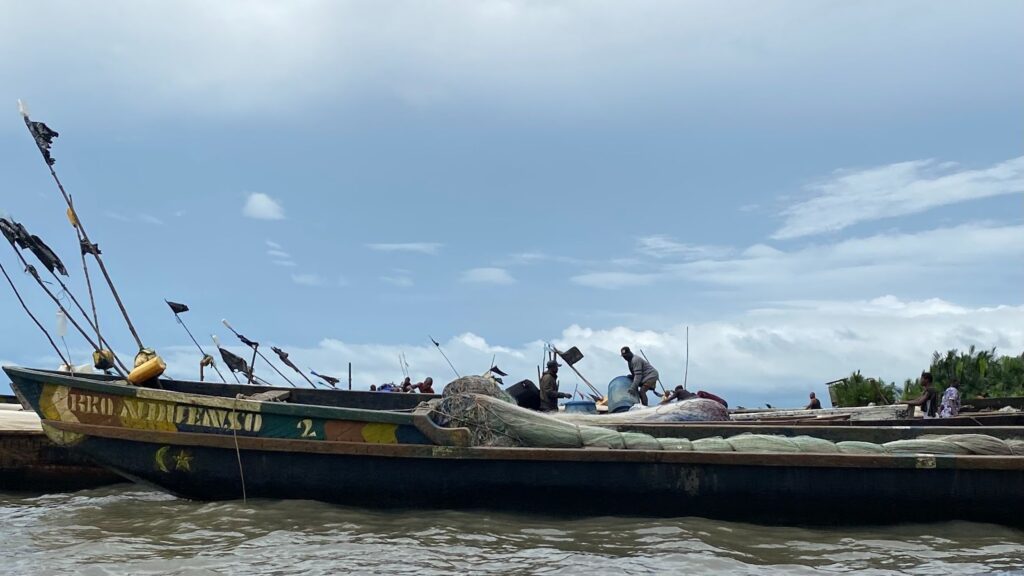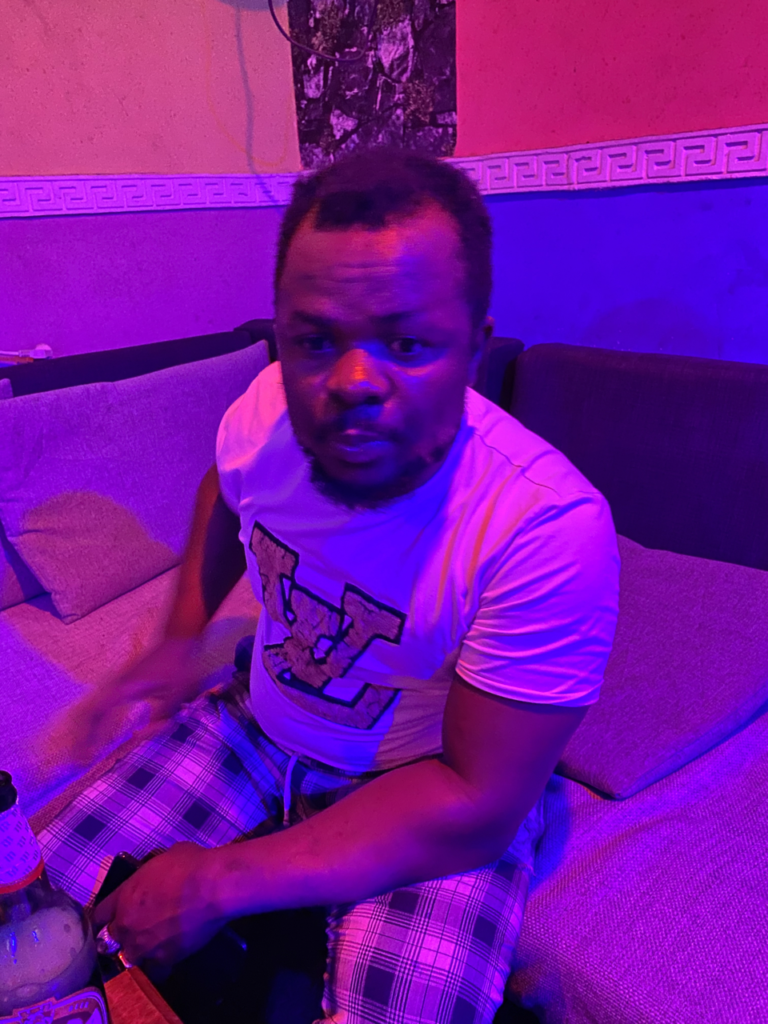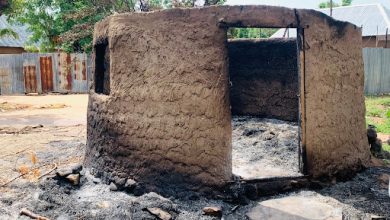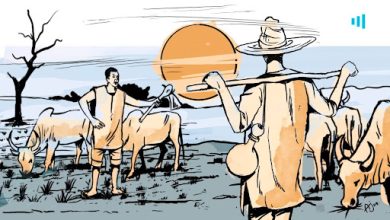Financing The Ambazonian Dream
On Oct. 1, 2017, Julius Ayuk Tabe declared an independent state called Ambazonia in the southwest and northwest regions of the Republic of Cameroon. The government clamped down on the separatists, and ever since, there’s been armed fighting. Why has the fighting raged on, and how is it being sustained?

Lambi, the son of a cocoa farmer, ditched his childhood dream to make his family proud by becoming an accountant. Nowadays, he carries a scratched-up AK-47 across his chest and a machete in his right hand, marching through the thick bushlands of Kumba with his comrades – men of the Ambazonia Defense Forces (ADF), just one of more than 50 secessionist armed groups demanding to break away from Cameroon.
Twenty-four years ago, he was born in an agrarian village in Kumba, in the southwestern English-speaking region of Cameroon. Lambi’s father, poor and uneducated, made unstable income from the family’s cocoa farm. But he loved formal education and made sure Lambi paid attention to his academics, insisting that none of his children would end up poor and uneducated like him.
He wanted Lambi to study at the university, get a good job and leave the village. Lambi knew his father’s desires and wanted to make him proud. He loved his family. Even though he’d always sneak out of the house to play football with his friends at the elementary school football pitch down the road, he would always come back early to assist on the cocoa farm. Some days, he would join his friends as early as 5 am to pick snails and ripe mango fruits in nearby bushes, which he would sell for a few Francs and give to his mother.
Lambi understood the condition of his village too: poor with mostly cocoa and plantain farmers. The houses, a mix of red mud and old block residential apartments, wear rusted, leaky roofs like hats. The walls, weakened by age, have map-like cracks that run from top to base of the buildings. The roads are untarred. There are no drainage systems.
So, Lambi’s dream to study accountancy at any of Cameroon’s English-language universities is not just for his good and his family’s. He wanted to help make life better in his village.
But on Oct. 1, 2017, Julius Ayuk Tabe declared the secession of Cameroon’s English-speaking southwest and northwest regions – historically known as the British Cameroons – to form the Federal Republic of Ambazonia.
That day changed the course of Lambi’s life.
Decades of pent-up anger
The English-speaking regions of Cameroon have historically complained of domination by the majority French-speaking regions. They say they have been sidelined in the public sector by the government led by Paul Biya, who has spent nearly four decades as president.
Cameroon was not a bilingual country. In fact, there are more than 200 local languages in the country of about 26 million people. Its journey to bilingualism started about two centuries ago.
In 1884, during the “Scramble for Africa,” Germany invaded Cameroon and started administering there and the country would be known as German Kamerun. Its borders were drawn through negotiations between the Germans, British, and French. The Germans governed the country for decades until its defeat in World War I and the then League of Nations mandated France to administer most of the territory and the United Kingdom – which was already administering neighbouring Nigeria – a small portion in the west.
After World War II, the United Nations, which succeeded the League of Nations, established a trusteeship system. This left France and Britain in control of their respective regions: French Cameroon and British Cameroon. These colonial powers would go on to entrench their cultures, including languages, local government, education, and legal systems in their respective colonies.
On Jan. 1, 1960, Cameroon gained independence. Ten months later, Nigeria gained independence from Great Britain, which was also administering the Southern Cameroons. The Southern Cameroons had complained of domination by Nigerians and being treated like the colony’s backwater. So, the UN thought there was a need for them to choose which country to belong to. In Feb. 1961, the UN organised a plebiscite and they voted to join French-speaking Cameroon. The union would give birth to the Federal Republic of Cameroon, where both the French and English parts would be mutually federated.
At the time, Ahmadou Ahidjo was the president of Cameroon. In 1972, he repudiated the federal structure on which the post-colonial unification was based and the English-speaking parts were annexed into a united republic.
In 1982, Paul Biya took over from Ahidjo. Two years later, Biya’s young regime scrapped the united republic and it became known simply as the Republic of Cameroon. The assimilation of the English-speaking minority took a swift swing.
The decades that followed would witness complaints of marginalisation related to the allocation of finance for development and appointment of public officials like governors of the two English-speaking regions who are usually picked from Francophone regions.
In 2017, the government allocated $225 million (FCFA 126 billion) to Biya’s South region while anglophone’s Southwest and Northwest regions had slightly over $77 million (FCFA 43 billion) and $76 million (FCFA 42 billion), respectively.
Anger ignites into fury
Cameroon has a dual legal system – One part is derived from French civil law, where laws are decided and written into statute at the political centre. The other operates in a minority of regions and comes from English common law, which relies on precedent set by past court cases. In Oct. 2016, lawyers in the English-speaking regions poured onto the streets to protest the domination by the French-speaking majority. They alleged that Francophone magistrates and notaries who did not understand English or the Common Law were posted to the Anglophone regions to do work done by lawyers under the Common Law system.
The lawyers demanded, among others, “the translation into English of the Code of the Organisation for the Harmonisation of Business Law in Africa (OHADA) and other legal texts.” School teachers, who would join the lawyers a month later, complained of “the appointment of teachers who did not have a good command of English and the failure to respect the Anglo-Saxon character of schools and universities in the Anglophone” regions. Other residents of the regions who felt cheated by the domination joined the protests too.
The government responded with force – security forces allegedly cracked down on the protesters and the clashes left many injured and 17 dead, according to Amnesty International.
The protesters, usually men and women aged between 20 and 60 years, continued to march on the streets in hundreds. The women, some with wrappers loosely tied around their waists, held hands and sang native songs. The men marched before them and stopping intermittently, to stand legs akimbo, thrusting fists into the sky and shouting words calling for justice. Most times the scenes quickly turned chaotic when the security forces arrived, firing teargas and a few warning shots into the air. The protesters would scamper for safety, running into any available space away from the shots.
This went on and a section of the population started demanding full secession. Tabe, then a 52-year-old ICT expert and motivational speaker with a wife and four kids, declared the secession and made himself the first president of the Interim Government of Ambazonia.
After the declaration, many residents of the region marched onto the streets in celebration and 23-year-old Davidson Ajabi, Lambi’s elder brother, was one of them. Davidson joined hundreds of others to march in Kumba III and waved the white and sky-blue flag of the newly declared state. Security forces confronted them and Davidson was shot.
“My brother was killed on the Oct. 1, 2017, protest. He was protesting on the street and he was shot and died instantly,” Lambi recounted.
Lambi was distraught and bitter. He wanted revenge, not just for the death of his elder brother, but for many others who had died in the clashes.
“The military was killing innocent people. So, I said if I can help to liberate them, that means I’d take up arms,” said Lambi.
“They shot at us with their big guns during peaceful protests and killed our brothers and sisters and children and then we took our own rifles to protect our own people. We started with peaceful protest and then stones and hunting guns. But now we have AK-47s.”
Tabe was later arrested with nine other separatist leaders in Abuja, Nigeria, and extradited to Cameroon. They were arraigned before a military court and were given a life sentence.

Unfinished negotiations
The clamour for a revert to the original arrangement has been on but has not been realised. This is the base of the frustration among the English-speaking populations, who make up about 20 per cent of Cameroon’s 26 million people.
When the confrontations started in 2016, there were calls for negotiations. The Cameroonian government did not immediately see it as the best option, but as the clashes increased with consequent deaths and displacement, it looked at the negotiation option again. In 2019, the Swiss government said it was facilitating a negotiation between the government and the separatist movement. Not much result came from the process. In July 2020, Al-Jazeera reported that the government held talks with separatist leaders for the first time since the crisis escalated.
But the fights are still on and experts say it could take time to deal with, especially now that smaller militia groups have sprung up.
Funding the fight
The crisis is now about five years old and is still ongoing. There are no fewer than 50 separatist groups located in various communities and forests in the regions and they have significant leaders to whom they are loyal. Most of these leaders are in the diaspora. For instance, the ADF – armed wing of the Ambazonia Governing Council (AGC) – which Lambi fights for, is led by Ayaba Cho who resides in Norway.
And these leaders and groups disagree due largely to issues on who would control the structure of the so-called government. The AGC has been in a tussle with the Interim Government (IG) over issues related to control of finance and mode of operation. A report by the Internation Crisis Group (ICG) stated that the IG’s monthly budget “reportedly varies from tens of thousands to a hundred thousand dollars.”
Inflows from Cameroon’s diaspora
The ICG says donations from the diaspora, including a significant number from women, is one source. Also, business people and shopkeepers are known to contribute in order to protect their premises from vandalism.
Njum is a fighter in Mankon, Bamenda, in the northwest region. He controls about 50 other active fighters and has more in training. His camp is loyal to the Southern Cameroons Restoration Forces formerly led by General Nyambere. He said he gets funding from the diaspora, though it has shrunk recently.
“I had [diaspora funding], but since the fight for the interim head of Ambazonia ensued, it stopped,” he said.
Significantly, most of the funding for the Ambazonia efforts evades Cameroon’s banking system. Mobile Money – an electronic wallet service that allows users to send, receive and store money on mobile phones – is the main channel. Popularly called Momo, the service is popular in Cameroon. A regular street in the country is punctuated with kiosks that have inscriptions indicating Momo service availability.
In local markets, payment for the purchase of items like fruits is easily made through Momo and bus and taxi drivers prefer quick Momo transfers to receiving notes. As of 2020, the Bank of Central African States (BEAC) reported that of the 30.1 million mobile money accounts that are active in the Central African Economic and Monetary Community (CEMAC) zone, Cameroon accounted for 64.8 per cent (19.5 million) – a significant number in a country with about 26 million residents.
So, with Momo, getting funding from supporters in the diaspora is practically easy. Up to 500,000 Francs could be sent in a single transaction after a few dials. Bypassing regulatory measures to get the fund is easy too. With just 1,000 Francs, a pre-registered SIM card could be bought and it takes a few seconds to activate Momo.
Apart from receiving funds from many locations largely unhindered, it could be discreetly arranged locally, too: “It comes county-by-county. If you come from this region/county, you can gather yourselves and money and send the funds to, maybe, family members,” said Njum. Receiving the funds from the family members could then be arranged through third parties to the fighters in their hideouts in forests.
Kawa Yannick is a former fighter in the Manyu division, Mamfe Central, southwest region, who fought from 2016 to 2019 before he embraced the government’s disarmament and demobilisation programme meant to reintegrate repentant fighters into society.
Another layer of the funding is through what the fighters call ‘support’ from Cameroonians who are outside the hard-hit areas and they come through the banks and are facilitated by middlemen.
“We hardly know names. If you are in Limbe or Douala, you send your support to us through someone [a middleman the fighters will appoint who is also an ally] and the person withdraws it and brings it to us; sometimes through the banks,” Yannick said.
“The government does not have much time with the middlemen. It focuses on those carrying arms.”
Taxes and community donations
While Njum said beyond diaspora donations, voluntary support from community residents is another funding channel for sustaining the secessionists’ campaign, Yannick, who controlled over 450 fighters in more than 30 communities, said taxes and levies are a crucial source of funds.
“We had taxes. If you are a businessman, you pay. Cocoa buyers have the amount they pay for a year to run their cocoa business. Every business person has their own levies to pay. We had controls [security checkpoints at strategic points on roads manned by armed fighters] and we judged cases,” said Yannick.
Across the towns where the fighting happens, like Bamenda, Kumba and Lebialem, which are usually called ground zero, fighters set up roadblocks. Due to the guerilla nature of the fighting, they always watch out for security forces. At the checkpoints, commuters make donations to them for ‘support’.
There have been allegations of commuters being forced to donate at checkpoints controlled by some of the fighters. Njum did not deny the allegations but blamed it on some groups of fighters who he said were not genuine and were out for their selfish gains.
“At the control posts, when buses are passing, passengers contribute. People contribute happily and some contribute not being happy,” he said.
“When the cars come, they stop; they say ‘if you want to support the struggle, you support, if you don’t want to support, nobody will force you.’ Anything you have, you chip in. Not everybody gives. Those who give are appreciated. Nobody will force anybody to contribute unless they have met a control with bad fighters.”
When they retreat to the forests, they sit, analyse the needs for funding, and decide what gets what amount of funds.
Kidnapping for ransom
In Manyu division, Mamfe Central, between late 2016 to 2019, Yannick led more than 450 secessionist fighters and kidnapping was a huge part of their activities.
Yannick embraced the government’s disarmament and demobilisation programme meant to reintegrate repentant fighters into society.
However, the kidnapping is still ongoing.
“I will not be shy to say it, kidnapping is one of the things that give income to support,” Njum said when asked if his group kidnaps to keep the fight going. But he has an excuse for it: “When you try to sabotage us and send the military at us, we know your family. We pick up the person and your family will pay the ransom.”
Njum’s statement confirms a long-held sentiment in some circles. Recently, there has been a wave of kidnappings. While some of the fighters make political demands – like the release of detained fighters – for their victims to be released, as in the case of the kidnap of Senator Regina Mundi in Bamenda in May this year, ransom demands are made discreetly. Senator Mundi was rescued by the military after being held at an unknown location in Bamenda for a month.
Last month, some of the fighters kidnapped a nun and three churchgoers from a Roman Catholic Church in Bamenda and demanded a ransom of $100,000. The victims are usually kept in bushes where the fighters camp.
“Kidnapped people only regain their freedom in exchange for ransom payments. I say this with full knowledge of the facts because two of my relatives were victims,” Ayah Paul Abine, a former Attorney General at Cameroon’s Supreme Court, said in a May report. And a journalist who did not mention his name confirmed that “this is how they finance their troops and the purchasing of weapons.”
Both Lambi and Njum denied that weapons were bought with proceeds from the kidnap of people.
“Part of our training was on how to attack military bases,” Yannick said. On several occasions, some fighters have launched attacks on security forces and carted away weapons, like in this June attack on a military outpost in a French-speaking area of Njitapon.

“For ammunition and others, we know how to get them. We know when to launch an attack and how,” Njum said and expressed unwillingness to provide further details.
Lambi’s response was not different.
“Each time we attack the military, we must make sure we take at least two guns from them,” he said with a firm voice that depicts experience and confidence. “So, we mostly get our guns from attacks on the military. You know it is guerilla war; we hide and attack, then run. They are bigger than us and we can’t confront them.”
‘To log trees, they must pay’
The forests are used for training. Yannick said his training and those of about 1,000 others took place inside the Korup National Park in the southwest region. The park extends over 1,260 km² of mostly primary forest and is reputedly one of Africa’s oldest and richest tropical forests in terms of floral and faunal diversity.
Cameroon is a biodiversity-rich country and the Anglophone regions where the conflict rages are biodiversity hotspots. The country has around 14 national parks, 18 wildlife reserves, 12 forest reserves and three wildlife sanctuaries hosting rare and threatened species.
The raging conflict has affected the environment. Most fighters have left their communities and set up camps in the forests. For instance, the Red Dragons militia in Lebialem has its camp at the heart of the Tofala Hill Wildlife Sanctuary.
Njum and his fighters reside in a forest in Bamenda and only go into the villages “when things are already hard in the forest”.
Before the conflict, the Cameroonian government and NGOs worked to reduce illegal logging, but that stopped as fighting escalated and separatist fighters relocated to the forests.
And this has spiked deforestation. According to the Global Forest Watch, tree cover loss in Cameroon increased from 117kha in 2016 when the conflict started to 187kha in 2017 when the fight intensified. The next year it was 121kha and 122 kha in 2019. In 2020, it spiked to 203kha and reduced a bit to 169kha in 2021. This is of great concern given that in 2015 when the conflict had not started, it was at 79kha.
Now, the forests serve as a finance funnel for sustaining the fight, Lambi says. And the funding comes in layers. First, Lambi’s group issues receipts to loggers when they pay – and they must pay before they are allowed to log. That’s not the end.
After the logging, while the loggers transport the logs out of the community, they meet the checkpoints controlled by other groups and pay before they are allowed to move.
“We are the government now and before individuals go to the forests to log trees, they must pay. We issue receipts to them to show they have paid. Some individuals who have their personal trees close to the forests can log, but before anyone goes into the government-owned forests, they must pay and be given permission to cut,” Lambi said.
While the fight goes on, the reasons for the initial discontent seem unresolved. And with the multiplicity of the groups, it is becoming increasingly difficult to fix the problem. The disarmament programme of the government is not yielding maximum results and distrust is still a big issue.
Njum says some fighters are ready for negotiations which should hold outside of Cameroon, but a more hardline Lambi does not see laying down his arms as an option.
In this complex, not just the environment, the fighters, women and children are affected, even the unborn kids, for no fault of theirs, have been drafted into the conflict.
“The government thinks that in the next two or three years, we will be tired and surrender. No! People are coming. Even if it takes the next 50 years, we are ready. If we die, our children will continue,” Njum said.
This story was produced with support from Tiger Eye Foundation and the MacArthur Foundation.
*Names of the fighters, apart from Yannick, were changed on demand.
Support Our Journalism
There are millions of ordinary people affected by conflict in Africa whose stories are missing in the mainstream media. HumAngle is determined to tell those challenging and under-reported stories, hoping that the people impacted by these conflicts will find the safety and security they deserve.
To ensure that we continue to provide public service coverage, we have a small favour to ask you. We want you to be part of our journalistic endeavour by contributing a token to us.
Your donation will further promote a robust, free, and independent media.
Donate HereStay Closer To The Stories That Matter




